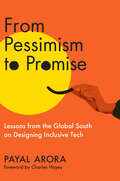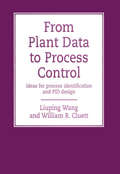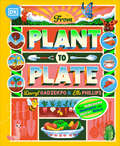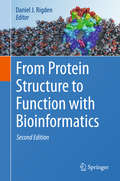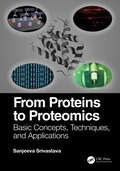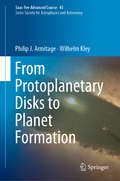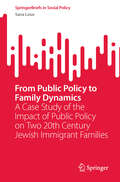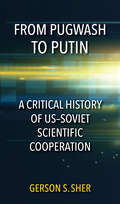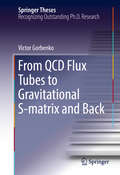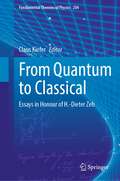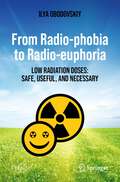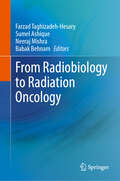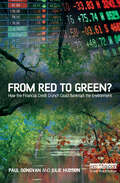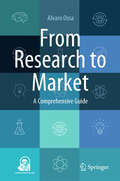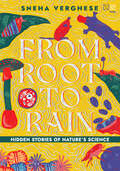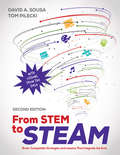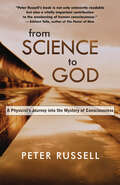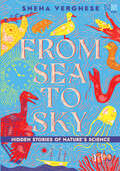- Table View
- List View
From Pessimism to Promise: Lessons from the Global South on Designing Inclusive Tech
by Payal AroraA radical paradigm shift in the way we think about AI and tech, taking hope and inspiration from the aspirational users of new technologies around the world.When it comes to tech, the mainstream headlines are bleak: Algorithms control and oppress. AI will destroy democracy and our social fabric, and possibly even drive us to extinction. While legitimate concerns drive these fears, we need to equally account for the fact that tech affords young people something incredibly valuable—a rare space for self-actualization. In From Pessimism to Promise, award-winning author Payal Arora explains that, outside the West, where most of the world’s youth reside, there is a significant different outlook on tech: in fact, there is a contagion of optimism toward all things digital. These users, especially those in marginalized contexts, are full of hope for new tech.As AI disrupts sectors across industries, education, and beyond, who better to shine the light forward, Arora argues, than the Global South, the navigator of all manner of forced disruptions, leapfrogging obstructive systems, norms, and practices to rapidly reinvent itself? Drawing on field insights in diverse global contexts such as Brazil, India, and Bangladesh, Payal describes what drives Gen Z to embrace new technologies. From Pessimism to Promise discusses the shift to relationally-driven approaches to design; how to create “algorithms of aspiration”; how to reimagine the digital space for sex, pleasure, and care; and, what we can learn from feminist digital activists and women’s collectives in the Global South on shared digital provenance and value, as well as indigenous approaches to sustainability, that challenges sacred ideas on degrowth, circular economy, and the doughnut economy. Arora also takes heart in the power in numbers, as the users from the majority world infuse algorithms with everyday aspirations, pushing for a new digital order.Timely and urgent, From Pessimism to Promise makes a deeply compelling case that it is not naïve to be optimistic about our digital future. On the contrary, it is our moral imperative to design with hope.
From Plant Data to Process Control: Ideas for Process Identification and PID Design
by Liuping WangProcess engineering spans industrial applications in the manufacturing sector from petrochemical to polymer to mineral production. From Plant Data to Process Control covers the most up-to-date techniques and algorithms in the area of process identification (PID) and process control, two key components of process engineering, essential for optimizin
From Plant to Human: The Extraordinary Spinach-Leaf Heart (Fountas & Pinnell Classroom, Guided Reading Grade 6)
by Oscar SilverNIMAC-sourced textbook
From Plant to Plate: Turn Home-Grown Ingredients Into Healthy Meals!
by Ella Phillips Darryl GadzekpoGrow mighty ingredients, then take them from mud kitchen to real kitchen and transform them into delicious, plant-powered feasts.Grab your shovel and plant for a recipe! Discover 15 incredible plants, including zucchini, raspberries, corn, and basil, then find out what it takes to make them grow. From showing you how seeds should be properly planted to helping you find the best soil for your plants, Darryl Gadzekpo and Ella Phillips offer all the tips and tricks green-fingered kids need to know to transform seeds into mighty fruit, vegetables, and herbs your tummies would be proud of.But the fun doesn't end here! Once you've removed those muddy boots, head to the kitchen and learn how to prepare and cook your home-grown ingredients. With more than 25 tasty recipe ideas from basil pesto pasta to butternut squash muffins, you'll master a variety of unique plant-powered food that you'll love to eat as much as you love to cook.A visual feast for 7–9-year-olds, From Plant to Plate is the perfect book to inspire kids to get growing, get cooking, and get plant-powered eating.
From Police to Security Professional: A Guide to a Successful Career Transition
by Michael S. D'AngeloFormer police and military personnel possess attractive skill sets for the private security industry; however, the transition to the corporate arena is not without challenges. Competition for these jobs is fierce. Many candidates possess degrees in security management‘some having spent their entire professional careers in private security. From Police to Security Professional: A Guide to a Successful Career Transition provides tips on overcoming the inherent obstacles law enforcement professionals face in making the switch and supplies a practical roadmap for entry into the private security world.The foundation of the book comes from the author‘s own journey and the many hurdles he encountered transitioning to private sector security. With his help, you‘ll learn: The unique skills, experience, and mentality required to enter into the private security industry from a law enforcement background The opportunities available and the different areas within the industry including benefits and income potential How to properly evaluate your training portfolio How to tailor your resume to garner the attention of hiring executives The many professional associations and certifications that could be helpful in your career Vital to your ability to succeed is understanding that security management has evolved into a distinct profession in its own right one that brings with it different education, experience, and skill sets that clearly differentiate it from law enforcement. This book will help you better understand and be prepared for the policies, processes, and a corporate environment that operates in a very different way than the police structure to which you are accustomed.
From Populations to Ecosystems: Theoretical Foundations for a New Ecological Synthesis (MPB-46) (Monographs in Population Biology #46)
by Michel LoreauThe major subdisciplines of ecology--population ecology, community ecology, ecosystem ecology, and evolutionary ecology--have diverged increasingly in recent decades. What is critically needed today is an integrated, real-world approach to ecology that reflects the interdependency of biodiversity and ecosystem functioning. From Populations to Ecosystems proposes an innovative theoretical synthesis that will enable us to advance our fundamental understanding of ecological systems and help us to respond to today's emerging global ecological crisis. Michel Loreau begins by explaining how the principles of population dynamics and ecosystem functioning can be merged. He then addresses key issues in the study of biodiversity and ecosystems, such as functional complementarity, food webs, stability and complexity, material cycling, and metacommunities. Loreau describes the most recent theoretical advances that link the properties of individual populations to the aggregate properties of communities, and the properties of functional groups or trophic levels to the functioning of whole ecosystems, placing special emphasis on the relationship between biodiversity and ecosystem functioning. Finally, he turns his attention to the controversial issue of the evolution of entire ecosystems and their properties, laying the theoretical foundations for a genuine evolutionary ecosystem ecology. From Populations to Ecosystems points the way to a much-needed synthesis in ecology, one that offers a fuller understanding of ecosystem processes in the natural world.
From Protein Structure to Function with Bioinformatics
by Daniel J. RigdenThis book is about protein structural bioinformatics and how it can help understand and predict protein function. It covers structure-based methods that can assign and explain protein function based on overall folds, characteristics of protein surfaces, occurrence of small 3D motifs, protein-protein interactions and on dynamic properties. Such methods help extract maximum value from new experimental structures, but can often be applied to protein models. The book also, therefore, provides comprehensive coverage of methods for predicting or inferring protein structure, covering all structural classes from globular proteins and their membrane-resident counterparts to amyloid structures and intrinsically disordered proteins. The book is split into two broad sections, the first covering methods to generate or infer protein structure, the second dealing with structure-based function annotation. Each chapter is written by world experts in the field. The first section covers methods ranging from traditional homology modelling and fold recognition to fragment-based ab initio methods, and includes a chapter, new for the second edition, on structure prediction using evolutionary covariance. Membrane proteins and intrinsically disordered proteins are each assigned chapters, while two new chapters deal with amyloid structures and means to predict modes of protein-protein interaction. The second section includes chapters covering functional diversity within protein folds and means to assign function based on surface properties and recurring motifs. Further chapters cover the key roles of protein dynamics in protein function and use of automated servers for function inference. The book concludes with two chapters covering case studies of structure prediction, based respectively on crystal structures and protein models, providing numerous examples of real-world usage of the methods mentioned previously. This book is targeted at postgraduate students and academic researchers. It is most obviously of interest to protein bioinformaticians and structural biologists, but should also serve as a guide to biologists more broadly by highlighting the insights that structural bioinformatics can provide into proteins of their interest.
From Proteins to Proteomics: Basic Concepts, Techniques, and Applications
by Sanjeeva SrivastavaProteomics aims to study all the proteins of human and other living systems, as well as their properties to provide an integrated view of cellular processes. The study of proteomics involves the application of rapidly evolving high-throughput technologies and new platforms that are coming forward regularly, providing versatile novel tools for biomedical and pharmaceutical applications. This book provides a detailed understanding of the basics of proteins and proteomics, gel based-proteomics techniques, basics of mass spectrometry and quantitative proteomics, interactomics: basics and applications, and advancements in proteomics. It also covers basic knowledge about sample preparation, mass spectrometry workflow, different chromatography technologies and quantitative proteomics. The text highlights the application and challenges of various high-throughput integrated proteomics technologies capable of fast and accurate screening of thousands of biomolecules, which are found to be very effective for studying disease pathobiology and identification of next-generation biomarkers and potential drug/vaccine targets; and are therefore considered valuable tools for multidisciplinary research. Features Basics of proteins and proteomics techniques In-depth understanding of mass spectrometry and quantitative proteomics An overview of interactomics and its application for translational research Advancement in the field of proteomics and challenges in clinical applications We hope the knowledge gained from reading this book will intrigue and motivate young minds to explore future opportunities in the constantly evolving field of proteomics.
From Protoplanetary Disks to Planet Formation: Swiss Society for Astrophysics and Astronomy (Saas-Fee Advanced Course #45)
by Philip J. Armitage Wilhelm Kley Marc Audard Michael R. Meyer Yann Alibert<p>Is the Sun and its planetary system special? How did the Solar system form? Are there similar systems in the Galaxy? How common are habitable planets? What processes take place in the early life of stars and in their surrounding circumstellar disks that could impact whether life emerges or not? <p>This book is based on the lectures by Philip Armitage and Wilhelm Kley presented at 45th Saas-Fee Advanced Course „From Protoplanetary Disks to Planet Formation“ of the Swiss Society for Astrophysics and Astronomy. The first part deals with the physical processes occurring in proto-planetary disks starting with the observational context, structure and evolution of the proto-planetary disk, turbulence and accretion, particle evolution and structure formation. The second part covers planet formation and disk-planet interactions. This includes in detail dust and planetesimal formation, growth to protoplanets, terrestrial planet formation, giant planet formation, migration of planets, multi-planet systems and circumbinary planets. <p>As Saas-Fee advanced course this book offers PhD students an in-depth treatment of the topic enabling them to enter on a research project in the field.</p>
From Public Policy to Family Dynamics: A Case Study of the Impact of Public Policy on Two 20th Century Jewish Immigrant Families (SpringerBriefs in Social Policy)
by Sana LoueThis compact book relies on the story of two intertwined Jewish immigrant families to tell a multigenerational Jewish story about the interplay between public/social policy, cultural categories, and the lived experience of working class immigrant Jews from Eastern Europe, including trans-/intergenerational trauma. Importantly, it focuses on the impacts of pre-Holocaust public policy, a significant departure from the Holocaust and post-Holocaust focus of much of the published literature relating to Jewish intergenerational trauma. As such, it offers the possibility of better understanding the far-reaching and perhaps unforeseen impacts of public policy. This book addresses events on both the micro and macro levels and is biographical, autobiographical, and historical in its scope. Sources for this work include archival materials, census records, maps, military records, birth and death certificates, congressional materials, newspaper articles, films, images, interviews with living family members, and secondary sources. Among the topics covered are: Russian, Soviet, and U.S. Eugenics: Family Internalization of Policy and Rhetoric The Intertwined Impact of Economics, Eugenic Policy, and Immigration Restrictions The Present Past: Policy, Identity, and Progeny From Public Policy to Family Dynamics: A Case Study of the Impact of Public Policy on Two 20th Century Jewish Immigrant Families adds a human face to writings related to public/social policy. As the book integrates understandings from diverse fields of study, students of public policy, social work, psychology, history, Jewish studies, immigration studies, bioethics, and public health, as well as social workers, bioethicists, and historians, would be most interested in reading this unique work.
From Pugwash to Putin: A Critical History of US-Soviet Scientific Cooperation
by Gerson S SherThese firsthand accounts of US and Soviet scientists communicating across the Iron Curtain offer &“a stunning portrait of Cold War scientific cooperation&” (Physics Today). For sixty years, scientists from the United States and the Soviet Union participated in state-organized programs of collaboration. But what really happened in these programs? What did the participants and governments hope to achieve? And how did these programs weather the bumpiest years of political turbulence? From Pugwash to Putin provides accounts from sixty-three insiders who participated in these programs, including interviews with scientists, program managers, and current or former government officials. In their own words, these participants discuss how and why they engaged in cooperative science, what their initial expectations were, and what lessons they learned. They tell stories of gravitational waves, classified chalkboards, phantom scientists, AIDS propaganda, and gunfire at meteorological stations, illustrating the tensions and benefits of this collaborative work. From the first scientific exchanges of the Cold War through the years following the fall of the Soviet Union, Gerson S. Sher provides a sweeping and critical history of what happens when science is used as a foreign policy tool. Sher, a former manager of these cooperative programs, provides a detailed and critical assessment of what worked, what didn&’t, and why it matters.
From QCD Flux Tubes to Gravitational S-matrix and Back
by Victor GorbenkoThis thesis studies various aspects of non-critical strings both as an example of a non-trivial and solvable model of quantum gravity and as a consistent approximation to the confining flux tube in quantum chromodynamics (QCD). It proposes and develops a new technique for calculating the finite volume spectrum of confining flux tubes. This technique is based on approximate integrability and it played a game-changing role in the study of confining strings. Previously, a theoretical interpretation of available high quality lattice data was impossible, because the conventional perturbative expansion for calculating the string spectra was badly asymptotically diverging in the regime accessible on the lattice. With the new approach, energy levels can be calculated for much shorter flux tubes than was previously possible, allowing for a quantitative comparison with existing lattice data. The improved theoretical control makes it manifest that existing lattice data provides strong evidence for a new pseudoscalar particle localized on the QCD fluxtube - the worldsheet axion. The new technique paves a novel and promising path towards understanding the dynamics of quark confinement.
From Quantum to Classical: Essays in Honour of H.-Dieter Zeh (Fundamental Theories of Physics #204)
by Claus KieferQuantum theory is at the foundation of the physical description of our world. One of the people who contributed significantly to our conceptual understanding of this theory was Heinz-Dieter Zeh (1932-2018). He was the pioneer of the process of decoherence, through which the classical appearance of our world can be understood. This volume presents a collection of essays dedicated to his memory, written by distinguished scientists and scholars. They cover all aspects of the interpretation of quantum theory in general and the quantum-to-classical transition in particular. This volume provides illuminating reading to anyone seeking a deep understanding of quantum theory and its relevance to the foundations of physics.
From Quarks to the Universe
by Eleftherios N. EconomouThis book takes the reader for a short journey over the structures of matter showing that their main properties can be obtained even at a quantitative level with a minimum background knowledge including first year calculus, the basic principles of quantum mechanics and the extensive use of dimensional analysis. The latter, besides some high school physics and mathematics, namely the atomic idea, the wave-particle duality and the minimization of energy as the condition for equilibrium are the basis of the book. Dimensional analysis employing the universal constants and combined with "a little imagination and thinking", to quote Feynman, allow an amazing short-cut derivation of several quantitative results concerning the structures of matter. In the current 2nd edition, new material and more explanations with more detailed derivations were added to make the book more student-friendly. Many multiple-choice questions with the correct answers at the end of the book, solved and unsolved problems make the book also suitable as a textbook. This book is of interest to students of physics, engineering and other science and to researchers in physics, material science, chemistry and engineering who may find stimulating the alternative derivation of several real world results which sometimes seem to pop out the magician's hat.
From Radio-phobia to Radio-euphoria: Low Radiation Doses: Safe, Useful, and Necessary (Springer Praxis Books)
by Ilya ObodovskiyThis book gives a detailed discussion of the initial enthusiasm triggered by the discovery of x-rays and radioactive radiation which later turned into fear and repulsion in a significant part of the global population up to the 21st century.After a historical review, the author discusses the effect of ionizing radiation on living cells, tissues and organisms. He then describes the relationship between the dose of radiation and the effect it produces. He shows how the dose-effect dependence is measured and what models of describing such dependences are used. He also discusses how radiation acts on living organisms: disorders in the genetic apparatus, mutation formation and so on. The book also includes detailed descriptions of the results of numerous health studies of large groups of people who, for one reason or another, were exposed to low doses of ionizing radiation, including those that significantly exceed the natural radiation background. The author concludes that low doses of radiation are safe and can even be beneficial (as known from medical radiation treatment); and also that the natural radiation background is necessary for the normal growth and development and well-being of a living organism. The author also discusses cases and effects of large doses, arguing, however, that dangerous doses of radiation are very unlikely. This book challenges radio-phobia. It not only offers arguments helping to overcome an unreasonable fear but, based on the latest understanding of science, argues to gradually move back, not to the former radio-euphoria, but to a new, conscious attitude towards radiation.
From Radiobiology to Radiation Oncology
by Neeraj Mishra Sumel Ashique Farzad Taghizadeh-Hesary Babak BehnamThis book offers a wide perspective on the fundamental and state-of-the-art knowledge in radiobiology, radiation oncology, and the connection between both fields. Chapters incorporate basic concepts of cancer biology and radiobiology with advances in radiotherapy in cancer treatment for various types of cancer. Chapters review one or more areas of radiation oncology with topics ranging from the application of radiotherapy in various cancers, the use of advanced techniques such as FLASH radiotherapy, applications of artificial intelligence in treatment planning, and more importantly, the current and potential strategies to reduce the toxic effects of radiation. This book incorporates interdisciplinary concepts by exploring recent approaches like radiogenomics for personalizing radiotherapy and the effects of the microbiome on radiation research. Teaching the basics of radiobiology and connections between the theory and the practical aspects of radiotherapy techniques, this book is a useful reference for cancer researchers, practitioners, interdisciplinary researchers in related fields, and students in radiation oncology and radiobiology. Through this integration of strong scientific foundations and clinical applicability, this book provides future research directions and rationales for readers looking to expand their knowledge about radiation with the most recent and essential data on the subject.
From Raindrops to Volcanoes: Adventures with Sea Surface Meteorology
by Duncan C. BlanchardWhere do raindrops come from? What happens when they hit the sea? What significant events occur where sea and air meet? Research scientist Duncan Blanchard -- a Fellow of both the American Meteorological Society and the American Association for the Advancement of Science -- examines these and many other questions in an effort to promote a better understanding of the atmospheric sciences. In the course of his investigation, he takes readers into the realms of meteorology, oceanography, physics, chemistry, and volcanology.In this popular treatment, Dr. Blanchard probes an exciting array of topics, among them The Flight of the Raindrops; The Surface of the Sea; Expulsion from Flatland; Electricity from the Sea; Volcanoes, Sea Water, and Electricity; and A Volcano at the Surface of the Sea. Readers are invited to perform experiments described in the text -- most of which can be carried out with a minimum of equipment.Presented in layman's language and filled with photographs and illustrations that enhance understanding, this book is a fascinating look at the workings of nature.
From Red to Green?: How the Financial Credit Crunch Could Bankrupt the Environment
by Paul Donovan Julie HudsonWritten by an economist and an investment professional, this book addresses the twin crises that the world is facing in the form of a simultaneous financial and environmental credit crunch. Financially, consumers are less able to consume now, and pay later. Environmentally, we may have already reached our credit limit and the bill for past financial and environmental consumption is falling due. Whether the financial credit crunch constrains consumers in a way that will be environmentally supportive, naturally slowing the consumption of finite resources, or hinders any effective resolution of the environmental credit crunch is of crucial importance. Policy responses to the financial crisis are likely to be constrained by the political need to support the economic status quo, and when combined with a global reduction in available investment capital there are serious challenges ahead if the economic and environmental damage of the environmental credit crunch is to be minimised. This book asks whether financial crunch-induced changes in consumer behaviour will be enough to avoid, or reduce, the environmental crunch many believe is just round the corner. Donovan and Hudson combine their respective economic and environmental perspectives to address this key question, reviewing this 'tale of two crunches' from the perspective of different economic sectors. The answer to the conundrum this book poses may lie in the only unlimited resource on the planet - human ingenuity.
From Research to Market: A Comprehensive Guide
by Alvaro OssaUnlock the secrets to transforming research into impactful products and services that reach the market. This book is a vital resource for anyone involved in the journey from academia to commercialization. It outlines the main stages and key milestones of technology transfer in a clear and engaging manner, featuring real-world examples of successful university research outcomes. Analyse the circumstances behind their success and learn the essential steps for a successful technology transfer process. Designed as a go-to reference for researchers, doctoral and master's students, scientific entrepreneurs, and academics focused on innovation and entrepreneurship, this book is also invaluable for technology managers at universities, research centres, and public agencies. Enhance your understanding of technology transfer and gain practical knowledge to navigate this complex field successfully.
From Root to Rain: Hidden Stories of Nature’s Science
by Sneha VerghesePlants that look like stones.The cell and its self-destructing zones. Clocks in our bodies that tick without pause. Seeds that catch on like claws. Dung beetles that are very choosy about. . .poop. Bacteria with team spirit, working in a group. Birds that behave like bats. ARE THESE REALLY FACTS?Find out about all these and more in this thrilling collection of 25 captivating stories that takes you up in the sky, under the sea, over hills, through jungles and across the world in a way you never thought possible. Introducing keen young readers to fascinating science in the environment around them, these tales simplify complex concepts into easy-to-follow ideas, while answering questions, explaining scientific phenomena and sparking curiosity to explore the secret world of Nature. Gear up for an exhilarating adventure of discovery!
From STEM to STEAM: A Study of Art from the Perspective of Science, Technology, Engineering, and Mathematics (Synthesis Lectures on Engineering, Science, and Technology)
by Arthur David SniderThis book provides readers with an introductory overview of art from the perspective of science, technology, engineering, and mathematics. The author utilizes well-known and important works of art to demonstrate how STEM concepts apply to them. The book’s examples include a structural analysis of Michelangelo’s David. The author covers major breakthroughs in art history, such as the discovery of perspective. The book also discusses other important elements of art, such as color, from a scientific point of view. The author ensures that readers will understand the art terms used by comparing them with terms used in STEM fields of study.
From STEM to STEAM: Brain-Compatible Strategies and Lessons That Integrate the Arts
by Dr David A. Sousa Thomas J. PileckiWeave arts activities to STEM instruction, and STEAM ahead to academic success Arts activities enhance the skills critical for achieving STEM success, but how do busy STEM educators integrate the arts into sometimes inflexible STEM curriculum? This new edition of From STEM to STEAM explores emerging research to detail the way. It includes: Classroom-tested strategies, including sample K-12 lessons plans and planning templates. Tools for building a professional development program designed to helps arts and STEM teachers collaborate to create STEAM lessons. Sample planning frameworks for transitioning schools from STEM to STEAM. The main objective of both art and science is discovery. Lead your students to make that connection and STEAM ahead to academic success!
From STEM to STEAM: Brain-Compatible Strategies and Lessons That Integrate the Arts
by Dr David A. Sousa Thomas J. PileckiWeave arts activities to STEM instruction, and STEAM ahead to academic success Arts activities enhance the skills critical for achieving STEM success, but how do busy STEM educators integrate the arts into sometimes inflexible STEM curriculum? This new edition of From STEM to STEAM explores emerging research to detail the way. It includes: Classroom-tested strategies, including sample K-12 lessons plans and planning templates. Tools for building a professional development program designed to helps arts and STEM teachers collaborate to create STEAM lessons. Sample planning frameworks for transitioning schools from STEM to STEAM. The main objective of both art and science is discovery. Lead your students to make that connection and STEAM ahead to academic success!
From Science to God: A Physicists Journey into the Mystery of Consciousness
by Peter RussellFrom Science to God offers a crash course in the nature of reality. It is the story of Peter Russell's lifelong exploration into the nature of consciousness — how he went from being a strict atheist, studying mathematics and physics at Cambridge University, to realizing a profound personal synthesis of the mystical and scientific. Using his own tale of curiosity and exploration as the book’s backbone, Russell blends physics, psychology, and philosophy to reach a new worldview in which consciousness is a fundamental quality of creation. He shows how all the ingredients for this worldview are in place; nothing new needs to be discovered. We have only to put the pieces together and explore the new picture of reality that emerges. From Science to God is as much a personal story of an open-minded skeptic as it is a tour de force of scientific and religious paradigm shifts. Russell takes us from Galileo’s den to the lecture halls of Cambridge where he studied with Stephen Hawking. “If you had asked me then if there was a God,” says the best-selling author of his scientific beginnings, “I would have pointed to mathematics.” But no matter what empirical truths science offered Russell, one thorny question remained: How can something as immaterial as consciousness, ever arise from something as unconscious as matter?
From Sea to Sky: Hidden Stories of Nature’s Science
by Sneha VergheseTrees with 'ears'. Mosquitoes that are saviours. Octopuses that operate tools and hoard rubble. A bird that pretends its way out of trouble. Butterflies that leave ants in a daze. A creature that can survive nuking, toxins and even outer space. Birds obsessed with blue. IS ALL THIS REALLY TRUE? Find out all about these and more in this exciting collection of 25 fascinating stories that takes you up into the sky, under the oceans, over mountains, through forests and across the world in a way you never imagined. Introducing eager young readers to amazing science in the environment around them, these tales break down complex concepts into easy-to-follow ideas, while answering questions, explaining scientific phenomena and sparking curiosity to explore the secret world of Nature.Get set for a roller-coaster ride of thrilling discoveries!
